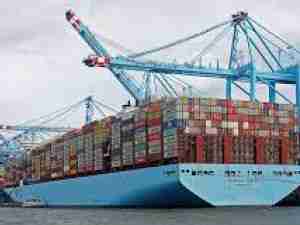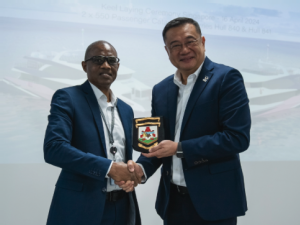The maritime world went into overdrive this week to dislodge one of the world’s biggest ships after it got jammed in Egypt’s Suez Canal, laying bare the fresh challenges the industry must navigate as mammoth vessels play an ever larger role in global trade.
The container ship Ever Given got stuck across the canal early Tuesday, and about 48 hours later tugs and diggers are still struggling to get it afloat. The Ever Given can haul more than 20,100 steel boxes, making it one of the largest container ships, according to Jayendu Krishna, director of maritime advisors at the consultancy Drewry. Such vessels can be longer than the Eiffel tower, and bigger than three soccer fields.
Around the world, ships have ballooned in size because the industry has looked for economies of scale, but these mega vessels have also drawn concerns. Shipping companies have used them to lower costs per unit, but that’s putting pressure on ports to make their waterways deeper and spend on more cranes, said Park Moo-hyun, a Seoul-based analyst at Hana Financial Investment Co.
Clive Reed, founder of Reed Marine Maritime Casualty Management Consultancy said there’s a risk of large container ships running aground in the Suez Canal if traveling at high speed.
“I am not surprised this has happened,” he said. “Once it is out of dead center, it will get sucked to one side or another, hence sinking sideways into the canal embankment.”
The Suez Canal Authority said a lack of visibility due to bad weather and a sand storm led to the ship losing control and drifting. The Ever Given “was grounded accidentally after deviating from its course due to suspected sudden strong wind,” Taiwan-based Evergreen Line, the time charterer of the vessel, said via email.
The Suez Canal has had to contend with ever larger container vessels with the average tonnage per ship reaching 119,000 tons in the 12 months to Feb. 28, 2020 from 93,500 tons in 2015, S&P Global noted this week.
Adding Ships
Globally, there are about 180 vessels that can each carry more than 15,000 containers, according to Um Kyung-a, an analyst at Shinyoung Securities Co. in Seoul. The industry’s appetite for these big ships was sparked when A.P. Moller-Maersk A/S took delivery of Emma Maersk, which could carry 15,000 containers, in 2006. Since then, shipping companies have been competing to build bigger ships.
At least 47 more ultra-large container vessels are expected to be delivered by 2024, according to research firm Drewry. A vessel that can carry 20,000 containers costs about $144 million and those carrying 23,000 cost more than $150 million, Drewry estimates. Companies like CMA CGM SA and HMM Co. expect to take deliveries of these ships almost every other month this year.
Images showing the fully loaded Ever Given blocking the canal put a spotlight on a container shipping industry that’s been straining at full capacity for the past six months, trying to deliver goods as consumers, restricted from traveling because of Covid-19, spend more on household goods instead.
Global Trade
Managing big ships like the Ever Given can be particularly hard when there are big wind gusts in places like the Suez Canal, according to a former crew member. The ship’s enormous size means it can be pushed into wind gusts and turned sideways fast, he said.
More than 180 vessels are caught up in the traffic snarl in both directions in the canal, a global trade artery. Refiners across the world use the route heavily, raising worries that global energy markets could be affected by the blockage.
Growing ship sizes also pose a problem for ports on the U.S. West Coast, where Los Angeles and Long Beach, California can’t easily handle ships holding more than about 15,000 containers. That means that the super-sized vessels mainly ply between Asia and Europe, with places like Shanghai, Singapore and Rotterdam being some of their preferred ports of call.
Currently, South Korea’s HMM operates 12 of the world’s biggest container vessels, with each able to carry as much as 24,000 20-foot containers. Other companies such as CMA CGM, Mediterranean Shipping Co., Cosco Shipping Holdings Co. and Orient Overseas Container Line Co. also operate mega vessels that can each carry more than 20,000 boxes.
Building even bigger ships won’t be likely because it will require changes in the design and more investments will be needed to be made at ports, said Um.
“The Ever Given incident has raised the need to relook at some of the contingency plans these canals have to prevent this from happening again,” said Um. “A lot of large vessels do go through the Suez Canal every day but when one gets into trouble like what’s happened now, the impact is just too big.”
Rising Demand
Global trade in merchandise has recovered to pre-pandemic levels as the coronavirus triggered demand for household goods. Ports are congested from Los Angeles to Rotterdam as the pandemic affected land transport and operations at ports. All that has fueled high demand for container ships.
Meanwhile, there were bottlenecks on the U.S. West Coast that spread across the world and also triggered a jump in rates. Spot rates to haul a 40-foot container to Los Angeles from Shanghai almost tripled last year, according to the World Container Index.
Large ships remain one of the most important cogs in the world of global trade. Still, groundings are far from the only challenge to beset major shipping vessels, S&P noted this week. One of the industry’s most recent challenges has been a series of losses at sea during the winter storm season in the Pacific that have led at least five ultra-large vessels to lose containers, the firm said.
The Suez incident is an example of the fragility of maritime commerce and global supply chains that should be addressed, said Ian Ralby, chief executive officer of I.R. Consilium, a maritime law and security consulting firm that works with governments.“By the time canals are completed, they’re always too small to handle the biggest ships,” he said. “This forces us to look at where infrastructure is today and where we think it ought to be, otherwise we’ll never get it caught up and in alignment.”










